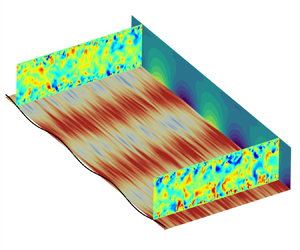Article contents
About the role of the Hanratty correction in the linear response of a turbulent flow bounded by a wavy wall
Published online by Cambridge University Press: 27 July 2023
Abstract

Scallop patterns forming on erodible surfaces were studied historically using a linear analysis of the inner region of a turbulent boundary layer growing on a corrugated wall. Experimental observations show a phase shift between the shear stress at the wall and the wall oscillation that depends on the wavenumber. An ad hoc correction applied to the turbulent closure and due to Hanratty et al. (Thorsness et al., Chem. Engng Sci., vol. 33, issue 5, 1978, pp. 579–592; Abrams & Hanratty, J. Fluid Mech., vol. 151, issue 1, 1985, p. 443; Frederick & Hanratty, Exp. Fluids, vol. 6, issue 7, 1988, pp. 477–486) was systematically used to recover the reference experimental results. In this study, Reynolds-averaged Navier–Stokes (RANS) and direct numerical simulations (DNS) were performed and revealed the role of the Boussinesq assumption in the results obtained. We show that the Hanratty correction acts as a palliative to the misrepresentation of Reynolds stresses due to the use of the Boussinesq hypothesis. The RANS calculations based on a turbulence model using a second-order moment closure recovered the expected results obtained in the reference DNS calculations, in particular with respect to wall heat transfer. The analysis of these results highlights the critical importance of the anisotropy of the diagonal Reynolds stresses on the prediction of wall transfer under these conditions and their implication in the occurrence of scalloping.
Information
- Type
- JFM Papers
- Information
- Copyright
- © The Author(s), 2023. Published by Cambridge University Press.
References
- 5
- Cited by


